DonQuixote
Starting the Game
With /join 1-4 players can join the game. With /start the game begins. alternative, you can use the Game Tool
Object of the Game
DonQuixote is a jigsaw puzzle, where each player must try to interpret their tiles the best possible way, in order to build a road network which connects the maximum number of elements of the game (churches, windmills, knights). But even your best tile can, if played at the wrong time, scupper your plans plan. You need to balancing look to optimize your tiles in your principality as the game plays out.
Game board
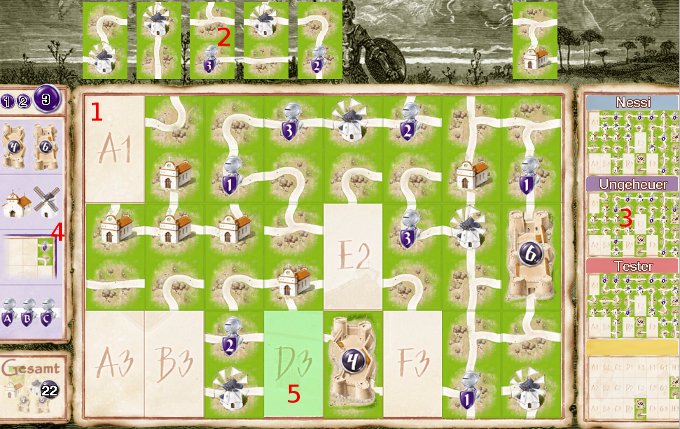
- Principality
- Road Tiles
- Players display: If you move your mouse over an opponent's name, you can see their principality full-size. The background colour for a player's names disappears when a player has placed a tile for the current round.
- Score Summary/Aide (See below)
- Current play location
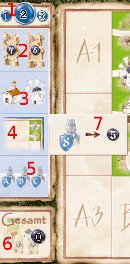
- Current Round Display: (the number of the current round is displayed larger).
- Score for Castles
- To see: Score for Churches and Windmills
- To see: Score for defending territories
- To see: Score for the largest group of knights (above 3)
- Current Point Total
The Current Total Score is displayed for all items to be scored. To display a particular section, move your mouse over the corresponding section as indicated above.
When you move your mouse over one of the four item selectors you will see your points for the round (the above example shows defending territories).
Starting The Game
Each player has an identical stack of 22 road tiles and a principality with 24 spaces. All castles are put in the same field of the principality. That field is chosen randomly.
Flow of the game
Each player wants play his 22 road tiles in his own principality. This happens over three rounds: In the 1st/2nd/3rd round each player places 9/7/6 road tiles in his principality. The current play space is selected randomly and refractive in green. This place is the same for all players. Each round ends with a scoring. After the third scoring, the game ends.
Playing the road map
During the first round, each player has 9 road tiles available. The location of play is sharp for all the players to see where they should play a road tile. (Here on BrettspielWelt the field is marked in green). For instance, if B4 is uncovered, all players must place one of their nine road tiles on B4. When playing the cards, the following rules must be followed:
- A player may choose any tile in their hand. Exception: During the third round, the tile on the right must be placed last! Drag and drop your card selected to the highlight green space (and only there!)
- Each card can be turned, before being placed180 degrees. Other directions are Not applicable possible! To turn the card, a player has to click the upper or lower area of the card once
- A placed card can no longer be moved!
- It is not necessary to place the card so that like features meet surrounding tiles (unlike Carcassonne: street-street or meadow -meadow).
- Every castle has exactly two road connections. The castle separates both the roads.
Scoring
All three rounds are scored immediately. The 'Largest Group of Knights' is only scored after round three (see below). "Joined means that for scoring purposed they must be "joined by roads." The points are scored as follows:
Churches and Windmills
Points for Churches only score if they are joined to other churches. A single church not being joined by road to any other church scores zero. For exactly two joined churches you score two points. For larger groupings you score two points per church (for example, four churches scores eight points). windmills are scored in the same way as the churches. Having only 1 church and 1 windmill joined scores zero!
Castles
Castles are scored by combining with knights. The Quantity of the knights are used to score: During rounds 1/2/3 you must have 1/2/3 knights joined to that castle. The strength of the knight is irrelevant. If these conditions are met you score the value of the castle. Knights joined to both castles can be counted for both.
Defense
For a knight to be considered as defending thence it must meet the following criteria:
(a) He must be placed on ta border tile of the principality.
(b) There must be direct road the knight is on linking to the outside.
c) The knight must be on the outside of the tile nearest to the border.
All knights who satisfy these conditions add their value to the defense of the province. During rounds 1/2/3 your total defense must achieve 4/8/12. If you achieve this target you score five points.
Example of a defense of the principality
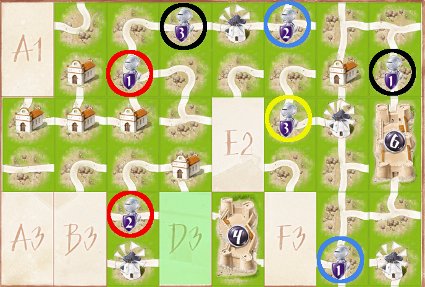
- The yellow-circled knight does not meet requirement (a) since he is not on the border of the principality.
- The black-circled knights do not meet requirement (b), as though they are on the border, their roadways do not point directly to the outside. The left knight's road does not cross the border while the right knight's road on his helped of the tile so does not cross the border.
- The red-circled knight does not satisfy requirement (c). Although his tile is on the periphery of the principality, he is on the half which is not adjacent to the border.
- The blue-circled knights meet all conditions and therefore contribute a total strength of "3" for defense of the principality.
Example of the second scoring:
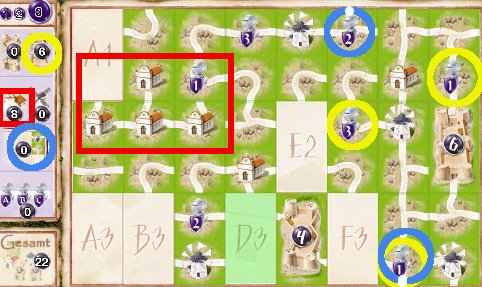
- There are three yellow-circled knights joined to the #6 castle. There are no knights connected to the #4 castle, so scoring zero. Castle 6 is connected with three knights. Since it is the second round, at least two knights would need to be connected, incident scoring six points.
- Highlighted in red rectangle are four joined forces. Being greater than two joined churches they score two points each, therefore giving a total of eight points.
- For the defense of the principality during round two the requirement is a strength of eight. There are only two eligable knights (blue circles), with a total strength of three, therefore scoring zero points for this element.
Largest Group of Knights
The largest group of knights is only scored after the Last round . This is evaluated as the highest strength of one single joined group, and added to the total score.
Final scoring
Example of a final score. The scoring shown here on the left in the scoring area is the results of the third round, ie the mouse (in the picture invisible) was held on the red Round Three of the screen.
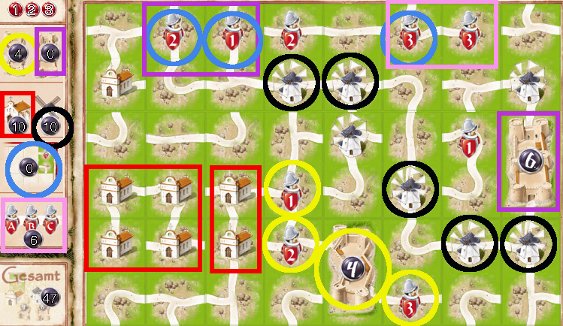
- Castle #4 has three knights attached (yellow circles) -> 4 points
- Castle #6 only has two knights (instead of the required three knights attached (purple rectangle) -> 0 points
- Attached churches (in this example 4 joined and 2 joined) [red rectangles] -> 2 x 4 + 2 = 10 points
- There are five joined windmills (black circles) -> 5 x 2 = 10 points
- After the third round, twelve points would have been necessary for the national defence. However, here only three knights with the summed strength of 6 contribute (blue circles) -> 0 points
- The largest single group of knights has a strength of 6 (pink rectangle) -> 6 points
The total score for the third round adds up to 30 points. With 17 points from the two previous rounds brings the total score up to 47.
End of the Game
The game ends after the third round. The winner is the player with the highest total score. As a Solitaire game the goal is to achieve the highest possible score.

